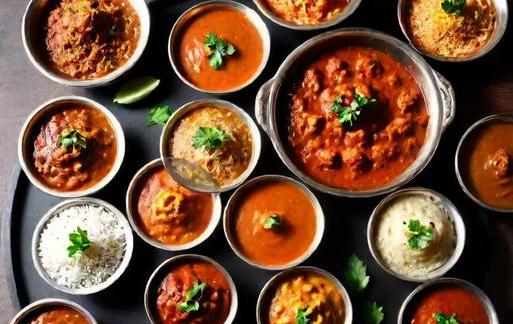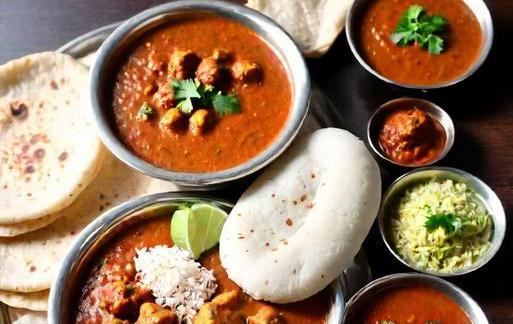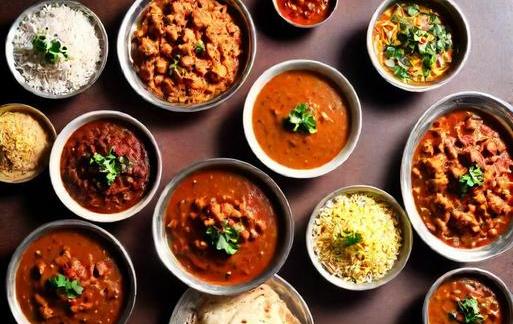- You are here:
- Home »
- Food
- » [REVEALED] Indian Foods That Start With F
[REVEALED] Indian Foods That Start With F
Note: This page contains affiliate links.
As an Amazon Associate, I earn from qualifying purchases when you click on the link, but you are not charged extra.
Indian cuisine is a rich tapestry of flavors, colors, and aromas that reflect the diversity and cultural heritage of the country. From spicy curries to aromatic rice dishes, Indian food offers a culinary journey like no other. In this article, we will explore a specific aspect of Indian cuisine – foods that start with the letter F. Whether you’re a seasoned food enthusiast or a curious culinary explorer, join us on this gastronomic adventure as we delve into the world of Indian foods that start with F.
Contents
List Of Indian Foods That Start With F

1. Falooda
Description: Falooda is a popular and refreshing dessert beverage that originated in Persia and made its way to India during the Mughal era. This delightful concoction is a layered drink that typically includes rose-flavored syrup, basil seeds (sabja), vermicelli noodles, and ice cream. It is often garnished with chopped nuts and offers a delightful mix of textures and flavors.
Preparation: To prepare falooda, start by soaking basil seeds in water until they swell. Cook vermicelli noodles separately. In a glass, layer the ingredients – first add rose syrup, followed by basil seeds, vermicelli, and finally, top it with ice cream. Garnish with chopped nuts for an extra crunch.
2. Fish Curry
Description: Fish curry is a beloved dish in coastal regions of India, where an abundance of fresh seafood inspires a myriad of culinary creations. This flavorful curry is made using a variety of fish, and the choice of spices varies from region to region. Common ingredients include tamarind, coconut milk, mustard seeds, and a blend of aromatic spices.
Preparation: To make fish curry, marinate the fish with turmeric, salt, and a touch of red chili powder. In a pan, temper mustard seeds in oil, add chopped onions, and sauté until golden brown. Add tomatoes, tamarind pulp, coconut milk, and the marinated fish. Simmer until the fish is cooked, and the curry reaches a rich, flavorful consistency.
3. Firni
Description: Firni, also known as phirni, is a creamy rice pudding that is a popular dessert during festivals and celebrations. This sweet treat is made with ground rice, milk, sugar, and flavored with cardamom or saffron. Firni is often garnished with chopped nuts and rose petals, adding both texture and visual appeal.
Preparation: Begin by soaking rice in water and then grinding it to a coarse paste. Boil milk and add the ground rice, stirring continuously to avoid lumps. Add sugar and let the mixture thicken. Flavor it with cardamom or saffron, and once the firni reaches a pudding-like consistency, pour it into serving bowls. Chill before serving.
4. Fara (Chana Dal Fara)
Description: Fara, also known as Chana Dal Fara, is a traditional dish from the state of Chhattisgarh. These steamed dumplings are made with a filling of chana dal (split chickpeas) seasoned with spices. Fara is often served with green chutney or a tangy tamarind sauce.
Preparation: To prepare the filling, cook chana dal until soft, then mash it and mix with spices like cumin, coriander, and chili powder. For the dough, combine wheat flour and water to form a smooth consistency. Roll out small discs, place the chana dal filling in the center, and fold the dough to form a dumpling. Steam the fara until cooked.
5. Fried Rice
Description: Fried rice, while not exclusive to Indian cuisine, has become a popular and versatile dish in India. Indian-style fried rice is often infused with local spices, vegetables, and sometimes protein such as chicken or prawns. The use of aromatic spices distinguishes Indian fried rice from its East Asian counterparts.
Preparation: Cook basmati rice and let it cool. In a pan, heat oil and temper cumin seeds. Add diced vegetables like carrots, peas, and bell peppers. Stir in cooked rice, soy sauce, and a blend of Indian spices such as garam masala. Toss the ingredients until well combined, and garnish with fresh coriander before serving.
6. Fenugreek (Methi) Paratha
Description: Fenugreek paratha, commonly known as methi paratha, is a popular unleavened Indian flatbread that incorporates fresh fenugreek leaves. This nutritious and flavorful paratha is a perfect accompaniment to curries, yogurt, or pickles.
Preparation: Clean and finely chop fresh fenugreek leaves. Combine the leaves with whole wheat flour, adding spices like cumin, coriander, and red chili powder. Knead the mixture into a soft dough, then roll it out into flatbreads. Cook the parathas on a hot griddle with a drizzle of oil until both sides are golden brown.
7. Fruit Chaat
Description: Fruit chaat is a refreshing and tangy salad made with a medley of fresh fruits, seasoned with chaat masala and a squeeze of lime. This delightful snack is popular across India and is often enjoyed during the scorching summer months for its hydrating and cooling properties.
Preparation: Choose a variety of seasonal fruits such as apples, bananas, oranges, and pomegranates. Dice the fruits and toss them together. Sprinkle chaat masala, black salt, and a dash of lime juice. Garnish with chopped mint leaves for a burst of freshness.
8. Fish Fry
Description: Fish fry is a delectable dish that showcases the diversity of Indian cuisine, especially in coastal regions. The preparation involves marinating fish with a blend of spices and then frying it until crispy and golden brown. The type of fish and the spices used may vary based on regional preferences.
Preparation: Marinate fish slices with a mixture of turmeric, red chili powder, garlic paste, and lemon juice. Let it sit for a while to absorb the flavors. Heat oil in a pan and shallow fry the fish until it is cooked through and has a crispy exterior. Serve with a side of mint chutney for a delightful experience.
9. Fried Modak
Description: Fried modak is a sweet delicacy often associated with Ganesh Chaturthi, a Hindu festival celebrating the birth of Lord Ganesha. These dumplings are made with a sweet filling of jaggery and coconut, encased in a crispy fried outer layer.
Preparation: For the filling, mix grated coconut and jaggery in a pan and cook until the mixture thickens. Allow it to cool. Prepare a dough with rice flour and water, similar to the one used for momos. Roll out small discs, place the filling in the center, and fold the edges to form a modak shape. Deep fry until golden brown.
10. Fennel (Saunf) Mukhwas
Description: Fennel mukhwas is a traditional after-meal mouth freshener that is not only delightful to the palate but also aids in digestion. Fennel seeds, also known as saunf, are coated with various spices and sugar, creating a sweet and aromatic blend.
Preparation: Mix fennel seeds with roasted and powdered coriander seeds, sugar, and a touch of cardamom. The combination of sweet and savory flavors makes it a perfect palate cleanser after a hearty meal. Store in an airtight container for a quick and convenient post-meal treat.
The world of Indian cuisine is vast and diverse, offering a plethora of dishes that cater to various tastes and preferences. The exploration of Indian foods that start with F has taken us on a journey through sweet and savory delights, each with its unique blend of spices, textures, and cultural significance. Whether you’re savoring the richness of fish curry, indulging in the sweetness of fried modak, or refreshing your palate with fruit chaat, these dishes exemplify the culinary excellence that defines Indian gastronomy. So, the next time you embark on a culinary adventure, consider trying one of these Indian delights that start with the letter F, and let your taste buds revel in the symphony of flavors that Indian cuisine has to offer.
Significance

Indian cuisine is a rich tapestry of flavors, spices, and diverse culinary traditions. Among the plethora of dishes that grace the Indian culinary landscape, there’s a fascinating array that starts with the letter "F." In this exploration, we delve into the world of Indian foods that begin with the letter F, unraveling the cultural and historical significance, exploring common themes, and uncovering interesting facts.
Before we embark on our culinary journey, it’s essential to understand the significance of food in Indian culture. Indian cuisine is more than just sustenance; it’s a celebration of diversity, history, and regional nuances. Each dish carries a story, often rooted in tradition and local ingredients. The importance of food in India goes beyond the mere act of eating; it is a reflection of the country’s rich heritage and a testament to the fusion of various influences over centuries.
Category-Related

1. Fritters (Pakoras And Bhajis)
One of the quintessential aspects of Indian cuisine is the love for deep-fried delights. Fritters, known as pakoras or bhajis, exemplify this culinary tradition. These crispy, golden bites are created by dipping vegetables, paneer (Indian cottage cheese), or even meat into a spiced chickpea flour batter before deep-frying. Favorites include onion pakoras, aloo bhajis (potato fritters), and spinach pakoras. Served with mint chutney or tamarind sauce, these fritters are a popular snack across the country.
2. Falooda
A cooling and delightful dessert beverage, falooda is a layered concoction that originated in Persian cuisine but found its way into the hearts of Indians. This dessert drink comprises rose-flavored milk, vermicelli, basil seeds, and ice cream. It’s a perfect amalgamation of textures and flavors, offering a sweet escape on hot summer days. Falooda reflects India’s historical openness to embracing and adapting culinary influences from different parts of the world.
3. Fish Curry
India’s vast coastline ensures an abundant supply of seafood, and fish curry is a culinary gem that showcases the coastal regions’ culinary prowess. Each coastal state offers its unique twist to this dish. Whether it’s the fiery Goan fish curry with coconut or the tangy mustard-based fish curry from Bengal, the diversity in preparation methods and spice blends is a testament to India’s regional culinary diversity.
4. Fenugreek Paratha
Bread is an integral part of Indian meals, and fenugreek paratha stands out as a flavorful and nutritious variant. Whole wheat dough is kneaded with fresh fenugreek leaves, spices, and sometimes yogurt. The resulting parathas are pan-fried to golden perfection. The earthy aroma of fenugreek and the crispy texture of the paratha make it a favorite breakfast option in many Indian households.
Common Themes
Despite the diversity in Indian cuisine, certain common themes and culinary practices are woven into the fabric of many dishes that start with the letter F.
1. Flavorful Spices
Indian cuisine is renowned for its bold and vibrant use of spices. Whether it’s the complex blend of spices in fish curry or the aromatic seasoning in fenugreek paratha, the use of spices like cumin, coriander, turmeric, and garam masala is a common thread. These spices not only add depth and complexity to the flavors but also contribute to the health benefits associated with Indian spices.
2. Vegetarian And Non-Vegetarian Variations
India is a land of diverse dietary preferences, and this diversity is reflected in its cuisine. Dishes that start with the letter F include both vegetarian and non-vegetarian options. While fenugreek paratha and falooda cater to the vegetarian palate, fish curry represents the delectable world of non-vegetarian delights. This duality in offerings is a testament to India’s inclusive culinary landscape.
3. Regional Variations
The beauty of Indian cuisine lies in its regional diversity, and this is evident in the varied interpretations of dishes starting with the letter F. For example, fish curry in Kerala might have a coconut-infused base, while in Maharashtra, it could be a fiery tamarind-based curry. Understanding these regional nuances adds depth to the appreciation of Indian culinary traditions.
Interesting Facts
Delving deeper into the culinary realm of Indian foods that start with F unveils a trove of fascinating facts that contribute to the uniqueness of these dishes.
1. Feni – A Unique Spirit
While not a dish in the traditional sense, Feni is a spirit that hails from the coastal state of Goa. Made from either cashew apples or coconut sap, this indigenous liquor has a distinct flavor profile. Often consumed during festivals and celebrations, Feni showcases the resourcefulness of Indian communities in crafting beverages with local ingredients.
2. Fusion And Adaptation
Many Indian dishes, including those starting with F, are a result of historical trade and cultural exchanges. The falooda, for instance, has Persian roots but has seamlessly integrated into the Indian culinary landscape. This adaptability and fusion of flavors are indicative of India’s history as a melting pot of cultures and influences.
3. Medicinal Properties Of Fenugreek
Fenugreek, a key ingredient in fenugreek paratha, is not only prized for its culinary use but also for its medicinal properties. It has been traditionally used in Ayurveda for its anti-inflammatory and digestive benefits. Incorporating such ingredients into everyday meals reflects the holistic approach to health embedded in Indian culinary practices.
4. Rituals And Festivals
Indian cuisine is closely tied to rituals and festivals, and certain dishes starting with F hold special significance during specific occasions. For example, pakoras and bhajis are often prepared during festivals like Diwali, symbolizing the joyous nature of celebrations.
Conclusion
In the grand tapestry of Indian cuisine, exploring dishes that start with the letter F provides a glimpse into the diverse and vibrant culinary traditions of the country. From the sizzling pakoras and bhajis that evoke the essence of Indian street food to the refreshing falooda that offers respite from the heat, each dish carries a story of tradition, adaptation, and regional pride. Whether indulging in the aromatic fenugreek paratha or savoring the myriad flavors of fish curry, one can’t help but be captivated by the rich and flavorful journey through the Indian culinary alphabet. As we conclude our exploration, we celebrate the fact that in every bite of Indian food, there’s a taste of history, culture, and the spirit of a nation that takes pride in its culinary heritage.


